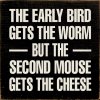alesh
Well-Known Member
Someone suggested that it would be useful to have a thread covering some math behind all those (not only) LED calculations.
So I'll start with explaining what luminous efficacy of radiation and quantum efficacy (?) of radiation are and how they can be calculated from a "spectrum curve".
Firstly we need to digitize an SPD. In this process the input is an image with the SPD curve and the output is set of corresponding relative power values for each unit of wavelength. That is, typically, 400 values between 380 nm and 780 nm. I’m using a software DigitizeIt for extracting the values.
Once this is done we can import the text data into Excel (or whatever you prefer) and plot an XY chart so we can see whether everything went ok.

^^^ a Cree SPD curve
 << text data imported to excel
<< text data imported to excel

^^^ text data plotted to a graph (for control)
LER – luminous efficacy of radiation. Tells us how many lumens each watt of a spectrum produces.
NOTE each watt radiated - not dissipated.
NOTE we’ll need luminous efficiency (luminosity) function in the same format as SPD. Refer to this page.
Now some math.
Let’s call SPD function J(λ) and luminosity function y(λ). Then LER can be calculated as following:

This might look a little strange for some but it’s not that complicated.
683.002 lm/W is a constant.
 is the area under the
is the area under the  graph (SPD multiplied by luminosity function).
graph (SPD multiplied by luminosity function).
 is area under the SPD graph.
is area under the SPD graph.
Still too much? In the language of Excel it’s pretty simple. Let’s have wavelength in column A, SPD in column B and luminosity function in column C. Column D should be filled with B*C then.


Now sum of B column is area under the SPD graph and sum of D column is area under the SPD*luminosity graph. Meaning LER = 683.002 * sum(D: D) / sum(B:B).

FFS I need to upload more files!
QER is gonna follow.
So I'll start with explaining what luminous efficacy of radiation and quantum efficacy (?) of radiation are and how they can be calculated from a "spectrum curve".
Firstly we need to digitize an SPD. In this process the input is an image with the SPD curve and the output is set of corresponding relative power values for each unit of wavelength. That is, typically, 400 values between 380 nm and 780 nm. I’m using a software DigitizeIt for extracting the values.
Once this is done we can import the text data into Excel (or whatever you prefer) and plot an XY chart so we can see whether everything went ok.

^^^ a Cree SPD curve
 << text data imported to excel
<< text data imported to excel
^^^ text data plotted to a graph (for control)
LER – luminous efficacy of radiation. Tells us how many lumens each watt of a spectrum produces.
NOTE each watt radiated - not dissipated.
NOTE we’ll need luminous efficiency (luminosity) function in the same format as SPD. Refer to this page.
Now some math.
Let’s call SPD function J(λ) and luminosity function y(λ). Then LER can be calculated as following:

This might look a little strange for some but it’s not that complicated.
683.002 lm/W is a constant.
 is the area under the
is the area under the  graph (SPD multiplied by luminosity function).
graph (SPD multiplied by luminosity function). is area under the SPD graph.
is area under the SPD graph.Still too much? In the language of Excel it’s pretty simple. Let’s have wavelength in column A, SPD in column B and luminosity function in column C. Column D should be filled with B*C then.


Now sum of B column is area under the SPD graph and sum of D column is area under the SPD*luminosity graph. Meaning LER = 683.002 * sum(D: D) / sum(B:B).

FFS I need to upload more files!
QER is gonna follow.
Last edited:














